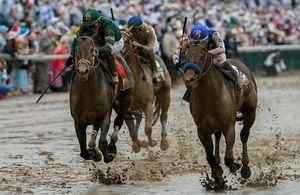Thousands took to the streets of Los Angeles on February 2, 2025, to protest against President Donald Trump's immigration policies, particularly his administration's aggressive actions toward undocumented immigrants. The demonstration started at Olvera Street around 11 a.m., with participants making their way toward City Hall, carrying Mexican and Central American flags and waving signs denouncing deportations.
The crowd, estimated to be thousands strong, swelled as they neared the 101 Freeway, where demonstrators eventually blocked traffic for hours, resulting in major congestion throughout downtown L.A. The protestors voiced their frustrations with chants such as "Si se puede!" and "El pueblo unido, jamás será vencido!" which translates to "Yes, it can be done!" and "The people united will never be defeated!" Signs displaying messages like “Protect people, not borders. Education, not deportation” emphasized their demand for more humane immigration policies.
This latest demonstration is part of continued protests following President Trump’s inauguration, which has seen U.S. Immigration and Customs Enforcement (ICE) target major sanctuary cities, including Los Angeles. Local businesses, particularly restaurants known for employing immigrant labor, expressed solidarity by closing their doors as part of the nationwide movement termed "A Day Without Immigrants." This initiative encourages immigrants and their allies not to work or shop as a demonstration of their contributions to the economy.
Many businesses participated, including popular spots like Teddy's Red Tacos and Dulan's Soul Food Kitchen, emphasizing how deeply woven immigrant labor is within California's culinary scene. NBC Bay Area reported significant absenteeism among farmworkers who are increasingly fearful of deportation, illustrating the broader effects of the government's crackdown.
During the protests, the California Highway Patrol restricted access to both directions of the 101 Freeway, reflecting the urgency of the situation as traffic snarled below. No arrests were reported by LAPD as of the evening, highlighting the peaceful nature of the protest. Despite prompt orders from police to clear the area, demonstrators remained unified until later hours.
Despite peaceful overtures earlier in the day, tensions escalated when police, after issues of traffic disruption, began issuing dispersal orders, eventually declaring the gathering unlawful around 8 p.m. According to the Los Angeles Police Department, some barricaded the street as far as the Main Street Bridge, restricting access and forcing their exit from the freeway.
The protests weren't without significant coverage from various media outlets. Reports indicated the outcry spread to cities beyond Los Angeles, with some participants rallying against Trump's policies across jurisdictions, including Riverside and San Diego, where smaller but equally vocal gatherings took place.
Activists carried messages of hope and resistance, stating their motivation was to stand against corporate silence on immigrant issues. One protester stated, "We're here to highlight the plight of millions who fear deportation and urge for sustainable reform. We are not going anywhere!" This sentiment of resilience reverberated not just throughout California but across the nation, as similar protests were reported in Texas and beyond.
The immediate response from local law enforcement reflected broader tensions brewing under the surface within communities. Observers noted the professional demeanor of many officers on duty, yet others alleged provocations on the police's side instigated confrontations later on. By the time protesters had gathered the following day, the anticipation around their movement gained momentum and support from local organizations, many of whom began advocating for immigrant rights more vocally.
The protests pose significant questions about the future of immigration policy and the role of local communities and businesses within the national conversation surrounding immigrant rights. Detractors of the Trump administration's policies are vocal about their belief the ethos of the American dream should promote inclusion rather than exclusion.
The organizers hope these protests reignite the discussion around immigration reform, not just locally but nationally. With protests structured to demonstrate the direct impact of immigrant contributions on various American sectors, the impact of their efforts remains to be seen.
Many demonstrators indicated they will continue to march and advocate for immigrants’ rights, amplifying their voices against policies they view as harmful to society. The impact of these demonstrations will likely ripple outwards—invoking conversations about human rights, immigration policies, and the integral role of immigrants in America’s economic fabric.
Overall, these protests encapsulate the collective frustration and hope of communities affected by the current administration's immigration policies. With the nation's eyes on Los Angeles, the protests represent more than mere dissent; they epitomize the broader struggle for dignity, remembrance, and acceptance across the United States.



